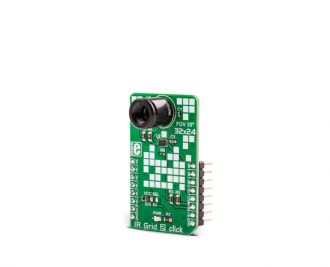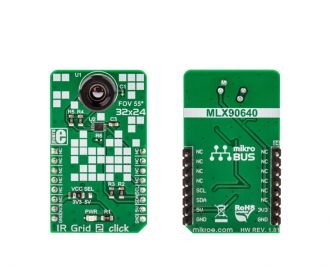
We strongly encourage users to use Package manager for sharing their code on Libstock website, because it boosts your efficiency and leaves the end user with no room for error. [more info]

Rating:
Author: MIKROE
Last Updated: 2018-10-22
Package Version: 1.0.0.0
mikroSDK Library: 1.0.0.0
Category: Optical
Downloaded: 3109 times
Not followed.
License: MIT license
IR Grid 2 click is a thermal imaging sensor. It has an array of 768 very sensitive factory calibrated IR elements (pixels), arranged in 32 rows of 24 pixels.
Do you want to subscribe in order to receive notifications regarding "IR Grid 2 click" changes.
Do you want to unsubscribe in order to stop receiving notifications regarding "IR Grid 2 click" changes.
Do you want to report abuse regarding "IR Grid 2 click".


Library Description
The library contains all the necessary functions for successful work with IR Grid 2 click.
Key functions :
void irgrid2_init() - Functions for initialization chipvoid irgrid2_getPixelTemperature(float *Ta, float *pixelTemp) - Functions for reads Ambient temperature and pixel temperatureExample description
The application is composed of three sections :
void applicationTask()
{
irgrid2_getPixelTemperature(&Ta,&pixelTemp[0]);
mikrobus_logWrite("Ambient temperature: ",_LOG_TEXT);
FloatToStr(Ta,demoText);
mikrobus_logWrite(demoText,_LOG_LINE);
mikrobus_logWrite(" ", _LOG_LINE);
mikrobus_logWrite("--- Pixel temperature matrix 32x24 ---", _LOG_LINE);
for ( cnt = 0 ; cnt < 768 ; cnt++)
{
FloatToStr(pixelTemp[cnt],demoText);
demoText[ 5 ] = 0 ;
mikrobus_logWrite(demoText, _LOG_TEXT);
mikrobus_logWrite("|", _LOG_TEXT);
Delay_1ms();
if(((cnt % 32) == 0) && (cnt > 0))
{
mikrobus_logWrite(" ", _LOG_LINE);
}
}
mikrobus_logWrite(" ", _LOG_LINE);
Delay_ms( 500 );
}
Other mikroE Libraries used in the example:
Additional notes and information
Depending on the development board you are using, you may need USB UART click, USB UART 2 click or RS232 click to connect to your PC, for development systems with no UART to USB interface available on the board. The terminal available in all MikroElektronika compilers, or any other terminal application of your choice, can be used to read the message.